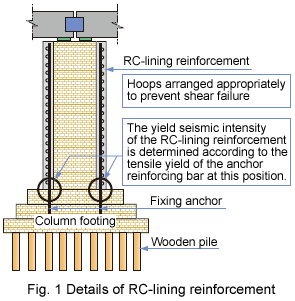 A number of brick/stone masonry bridge piers remain in existence, and these are gradually being reinforced, largely to strengthen their skeleton against earthquakes. However, no consideration is made of the present strength of the foundation. If the skeleton alone is reinforced, damage from large-scale earthquakes is likely to be concentrated on the foundation, as masonry bridge piers are generally built on old wooden pile foundations.
A number of brick/stone masonry bridge piers remain in existence, and these are gradually being reinforced, largely to strengthen their skeleton against earthquakes. However, no consideration is made of the present strength of the foundation. If the skeleton alone is reinforced, damage from large-scale earthquakes is likely to be concentrated on the foundation, as masonry bridge piers are generally built on old wooden pile foundations.
In consideration of the balance between the earthquake-resistance of the foundation and that of the reinforced skeleton, an RC-lining earthquake-resistance reinforcement method was therefore developed so that the reinforced skeleton can yield before the wooden pile foundation does in an L2 earthquake (Fig. 1). In the developmental process, a loading test was made on an RC-lining-reinforced bridge pier (Fig. 2) to verify the validity of this method. Since the method requires a sufficiently high performance of deformation even after the anchors fixed to footing have yielded, a number of large-diameter anchor pulling tests were implemented and proposed an appropriate anchor fixing method based on the test results.
In addition to the wooden pier foundation, a number of old bridge piers are constructed on floating foundations (i.e. the column-footing type of direct foundation). Since this kind of foundation can absorb earthquake motion with its deformation performance, however, it is sufficient to design strength of the reinforced skeleton on the assumption that it exceeds the strength of the floating foundation.
Summarizing these findings, a manual for practical L2 earthquake-resistance reinforcement work was compiled (Fig. 3). In contrast to conventional steel-plate lining reinforcement that requires a large number of shear-preventing reinforcing bars, this method requires no such bars at all. This brings cost cut and reduction of time for reinforcement work. |